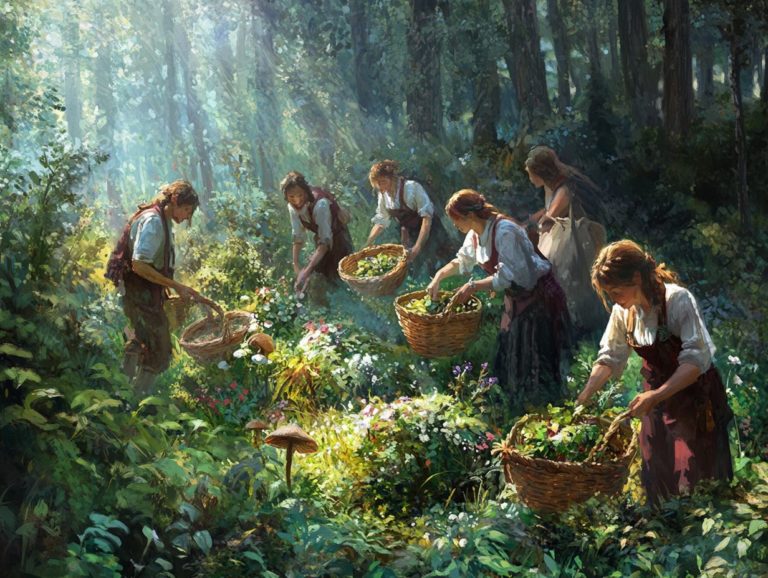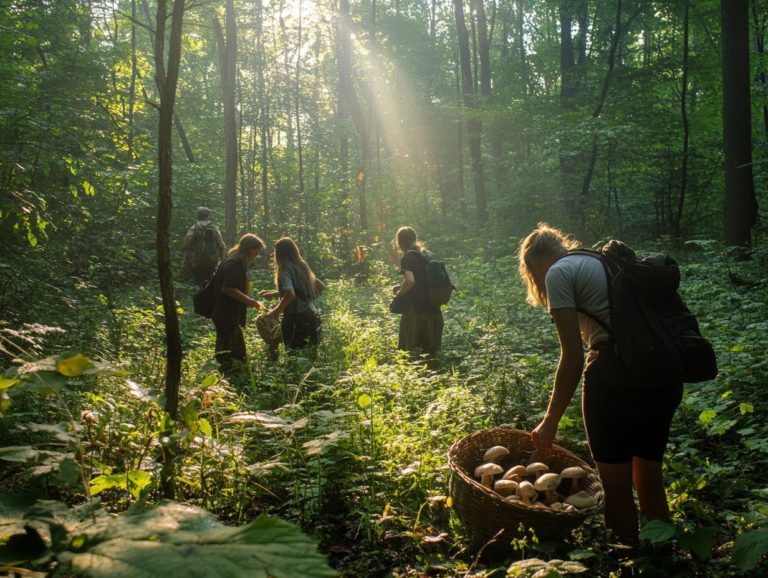Foraging Techniques for Medicinal Plants
Foraging, the timeless art of gathering wild food and medicinal plants, including urban foraging techniques, is much more than a mere survival skill; it s your gateway into nature s very own pharmacy.
This article will guide you through essential food foraging techniques, empowering you to identify valuable medicinal herbs by exploring their defining characteristics.
You ll discover the tools and equipment that can elevate your foraging adventures, along with sustainable gathering practices to safeguard our environment and natural resources.
You should also learn safe preparation techniques and recipes for your foraged treasures, ensuring you reap the rewards while practicing safe consumption and sidestepping any potential hazards.
Join us now to explore the exciting world of foraging!
Contents
- Key Takeaways:
- What is Foraging and Why is it Important?
- Identifying Medicinal Plants
- Foraging Tools and Equipment
- Sustainable Foraging Practices
- Processing and Using Foraged Medicinal Plants
- Safety Considerations
- Frequently Asked Questions
- What are foraging techniques for medicinal plants?
- What is wildcrafting and how does it relate to foraging for medicinal plants?
- How can I identify medicinal plants while foraging?
- What are some proper harvesting techniques for medicinal plants?
- Are there any safety precautions I should take while foraging for medicinal plants?
- Can foraging for medicinal plants have a positive impact on the environment?
Key Takeaways:

- Foraging is a vital skill for obtaining medicinal plants and connecting with nature.
- Key characteristics to look for when identifying medicinal plants include leaf shape, color, and smell.
- Essential gear for successful foraging includes a field guide, gloves, and a collecting bag.
What is Foraging and Why is it Important?
Foraging is the art of seeking out and gathering wild food resources, which often includes collecting edible plants, fruits, mushrooms, and medicinal herbs. Learning foraging techniques for nature walks can enhance this practice, promoting sustainability in urban environments and helping the community, inviting you to connect with your local ecosystem while appreciating the intricacies of food systems.
Learning to identify plants lets you forage safely, bolstering food security and engaging in a time-honored tradition that deepens your awareness of the world around you.
Identifying Medicinal Plants
Identifying medicinal plants is essential for anyone keen on utilizing the strength of wild edibles for their health benefits. Learning about mastering the art of wild foraging techniques enables you to safely recognize and harvest herbs like St. John’s Wort and Nettle.
By grasping the unique characteristics of these plants, you enhance your ability to prepare effective herbal remedies while ensuring safe consumption. This knowledge plays a vital role in embracing holistic health practices, which focus on treating the whole person, not just symptoms, elevating your journey toward wellness.
Key Characteristics to Look For
When foraging, it’s essential for you to identify key characteristics that distinguish wild edibles. Pay attention to aspects like leaf shape, flower color, and growth patterns, as these traits will help you confidently recognize plants such as Burdock and Dandelion as safe for consumption. Observing these features is crucial for anyone interested in herbal remedies and in grasping the importance of edible weeds in their local environment.
Take Burdock, for example; its broad, heart-shaped leaves are easily recognizable, particularly when they form a rosette pattern close to the ground. Similarly, the bright yellow flowers of Dandelion make their appearance early in the spring, creating a striking sight in meadows and gardens. Seasonal changes also influence your foraging efforts; as temperatures rise, the texture of leaves may shift, signaling their readiness for harvest.
Understanding the habitats whether shaded or sunlit will provide you with valuable insights into where to locate these precious plants. Each of these visual cues not only assists in identification but also underscores the profound connection between local flora and sustainable living.
Foraging Tools and Equipment

Equipping yourself with the right tools and equipment is essential for successful foraging. This preparation allows you to harvest food efficiently while learning foraging techniques for sustainable living and adhering to sustainable gathering practices.
Your essential gear should include:
- baskets for collection
- knives for cutting
- guides for plant identification
With these tools, you can engage with your environment both safely and responsibly, enhancing your foraging experience.
Essential Gear for Successful Foraging
Some essential gear for your foraging adventures includes a sturdy basket for collecting wild edibles and a reliable field guide for plant identification. You also need the right clothing and tools to ensure your safety while harvesting in various environments.
Understanding food safety is paramount, especially in urban foraging, where pollution and environmental factors can pose risks. A good pair of gloves protects your hands from prickly plants and contaminants.
A small knife or multi-tool is great for cutting edible parts safely. Don t forget to carry a water bottle to stay hydrated during your foraging excursions, especially in city parks where the allure of nature might distract you from your needs.
An apron with pockets keeps your tools handy, making foraging more efficient and enjoyable. Urban areas are treasure troves waiting to be explored, but it s crucial to learn the specific regulations regarding foraging in public spaces to ensure compliance and sustainability.
Sustainable Foraging Practices
Embracing sustainable foraging practices is essential for nurturing local ecosystems. These practices provide foraging enthusiasts with a wealth of wild edibles.
By cultivating an awareness of your surroundings and adhering to ethical gathering guidelines, you play a vital role in fostering community health and preserving the delicate balance between human consumption and nature s resources.
Protecting the Environment and Plants
Protecting the environment and plants during foraging is vital. Responsible practices ensure biodiversity and the overall health of ecosystems.
Consider factors like soil testing and the impact of your harvesting methods on local flora. Conducting soil tests helps identify potential contaminants and assess the health of the ground where you harvest.
This crucial step safeguards your health and helps maintain the integrity of the ecosystem. Understanding local habitats and respecting seasonal growth patterns minimize disruptions.
By foraging only in designated areas, you can prevent overharvesting and protect vulnerable species. By joining local conservation efforts, you become a steward of the land, ensuring that future generations can enjoy and benefit from nature’s bounty.
Processing and Using Foraged Medicinal Plants

Processing and utilizing foraged medicinal plants requires understanding various preparation techniques, including foraging techniques for outdoor enthusiasts, that turn raw herbs into potent herbal remedies for health and wellness.
By educating children about these processes, you cultivate a profound connection to nature and instill safe consumption practices. This nurtures a new generation of foragers equipped with knowledge and respect for the earth’s bounty.
Preparation Techniques and Recipes
Preparation techniques for crafting herbal remedies from wild edibles can vary tremendously. Methods like infusions, which involve steeping herbs in water, decoctions, where plant materials are boiled to extract flavors, and tinctures can provide unique ways to tap into the healing properties of plants like Mullein and Pine.
Incorporating these wild edibles into your recipes not only enhances your culinary experiences but also promotes safe consumption practices. For instance, steep Mullein in hot water to create a soothing infusion for respiratory health.
Pine needles can be dried and crushed into powder, perfect for flavoring baked goods while delivering a healthy dose of vitamin C. Consider experimenting with various preparations to discover the benefits of foraged medicinal plants.
A decoction of Dandelion roots can be brewed to support liver health, while a tincture made from Elderflower serves as a natural immune booster. Embrace these techniques to unveil the richness of nature and nurture your health through natural means.
Safety Considerations
Safety considerations are paramount when foraging. The ability to identify and avoid poisonous plants can be the fine line between health and illness.
By following established guidelines for safe foraging like consulting a reliable field guide and staying aware of your surroundings you can enjoy the benefits of wild edibles without the risks.
Avoiding Poisonous Plants and Other Hazards
Foraging tips to avoid poisonous plants are essential for anyone interested in wild edibles. Familiarize yourself with their identifying features and consider exploring foraging techniques for rural areas to enhance your knowledge.
Consult a field guide and join local foraging groups. Safe consumption is crucial, and understanding the common hazards is vital for anyone interested in wild edibles.
Utilizing smartphone apps for plant identification can be invaluable. These apps provide instant access to information and images right in the field.
Observe the habitat where plants grow; many edible species thrive in specific environments, while toxic varieties often prefer shaded or damp areas.
Join hands-on workshops to explore the world of foraging and learn from seasoned experts! Sharing knowledge in these communities enhances understanding and promotes safe foraging practices.
Frequently Asked Questions

What are foraging techniques for medicinal plants?
Foraging techniques for medicinal plants refer to methods used to identify, harvest, and prepare plants for their health benefits, including foraging techniques for plant identification, harvesting from nature, and proper collection techniques.
What is wildcrafting and how does it relate to foraging for medicinal plants?
Wildcrafting means carefully picking plants that grow in the wild for their health benefits. It is a vital part of foraging techniques as it allows for sustainable and ethical harvesting.
How can I identify medicinal plants while foraging?
There are several ways to identify medicinal plants while foraging, including referencing field guides, noting distinctive features like leaf shape and color, and using foraging techniques for wild greens by consulting with an experienced forager or botanist.
What are some proper harvesting techniques for medicinal plants?
Proper harvesting techniques include only taking what you need, leaving enough for the plant to regenerate, and using clean, sharp tools to avoid damaging the plant.
Are there any safety precautions I should take while foraging for medicinal plants?
Yes, always prioritize your safety. Wear protective clothing and gloves, avoid foraging near roads or polluted areas, and ensure you properly identify plants before consuming them to avoid allergic reactions or toxicity.
Can foraging for medicinal plants have a positive impact on the environment?
Yes, foraging for medicinal plants can positively impact the environment when done responsibly. It helps preserve native plant species, promotes biodiversity, and reduces the need for commercially grown plants. By learning about foraging techniques for sustainable practices, you can ensure that your foraging efforts benefit the ecosystem.
Start your foraging journey today, but remember to stay safe and informed!






